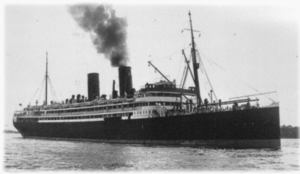RMS Niagara
 RMS Niagara. | |
| Career (UK) | |
|---|---|
| Name: | RMS Niagara |
| Owner: | Union Steam Ship Company |
| Builder: | John Brown & Company, Clydebank |
| Launched: | 17 August 1912 |
| Fate: | Sunk by sea mine, June 19 1940. |
| General characteristics | |
| Tonnage: | 13,415 gross tons |
| Length: | 165.5 m |
| Beam: | 20.2 m |
| Propulsion: | triple screw |
| Speed: | 17 knots |
| Capacity: | 290 first, 223 second, and 191 third class passengers |
Coordinates: 35°51′50″S 174°56′38″E / 35.86389°S 174.94389°E
RMS Niagara was an ocean liner launched on 17 August 1912 and owned by the Union Steam Ship Company. She was nicknamed "the Titanic of the Pacific", but after the sinking of the real RMS Titanic this was dropped in favour of "Queen of the Pacific".
At the start of World War II, RMS Niagara was operated by the Canadian-Australasian Line, maintaining a service from Auckland, New Zealand, to Suva and Vancouver.
On 19 June 1940 she was under the command of Captain William Martin and had just left Auckland when, off Bream Head, Whangarei, she struck a mine laid by the German auxiliary cruiser Orion and sank in 121 meters of water. No lives were lost but, unbeknown to all but a few, a secret and large consignment of gold from the Bank of England was in the Niagara's strong room and went down with the ship.
The gold was payment from England to the United States, which had not yet entered the war, for munitions in the fight against Germany.
A Melbourne company, United Propriety Salvage Ltd, was promptly contracted to recover the gold; at the time it was one of the deepest salvage operations ever undertaken.
The salvage team was led by Captain J. P. Williams and John Edwards Johnstone on the ship Claymore.
The Claymore
The Claymore, built in 1902, 260 tons gross, was an old coastal steamer. When first sighted for the salvage job she was a hulk rusting on the banks of Auckland harbour. Before recovering any gold the Claymore had to be salvaged herself.
Once the Claymore had been restored to working condition, the salvage team based themselves out of Whangarei and commenced operations on 15 December 1940. It took the Claymore approximately two months to locate the wreck, which they did by dragging their anchor along the seabed, and minefield. Twice during the locating phase of the operation she fouled unexploded mines and was almost sunk herself.
On 2 February 1941 the resting place of the Niagara was located and the salvage team started the arduous and hazardous task of retrieving the gold on behalf of HM Treasury. They were armed only with rudimentary equipment, a viewing/diving chamber, radio, and a grab lowered from the surface.
Williams and his team successfully recovered more than eight tonnes of gold after blasting a hole in the hull of the ship. 555 gold bars were removed, followed in 1953 by a further 30 gold bars, leaving 5 bars still unrecovered in the wreck.
The diving chamber used in the salvage is still in existence, on display at the Castlemaine Museum, located in the town of Castlemaine, Victoria, Australia, where it had been manufactured by Thompson's Foundry in late 1940.
Further reading
- R. J. Dunn, J. Johnstone. Niagara Gold: The romantic story of sunken treasure retrieved from record ocean depths, New Zealand. A.H. & A.W. Reed, 1942.
- Keith Gordon. Deep Water Gold: the story of RMS Niagara – the quest for New Zealand’s greatest shipwreck treasure. SeaROV Technologies, 2005. ISBN 0-473-10056-8. (Synopsis)
- James Taylor. Gold from the Sea. George G. Harrap & Co. Ltd., London, 1943
